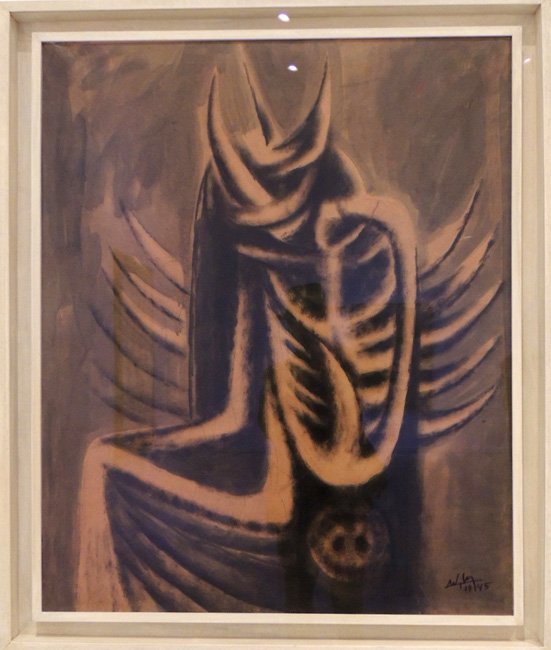Source: WTL photo© Wilfredo Lam exhibition in 2016 at the Museo Nacional Centro de Arte Reina Sofía in Madrid.
Image: "Canaïma [Escalopendre / La máscara (the mask)]" (1945). Oil on paper glued onto canvas. Centre Pompidou, Musée National d'Art Moderne, Paris.
Comments: In a number of indigenous Latin American cultures Canaïmais the key evil spirit that lurks in dense forests; for example, it can take the form of poisonous snake in the dense undergrowth, a werejaguar, or even a sharp branch that pokes people in the eye. Belief in the Canaïma spirit arises from these particular pre-Colombian people's disbelief in natural death; to them, when they "die" and therefore are no longer among the living, they have been stalked by this symbolic spirit, Canaïma, which in the end kills them. In deep Cuban culture, inherited from or influenced by the remnant of one of the beliefs of the Carib people, Canaïma (or Kanaima) is the evil spirit that people invoked with drugs or magic in order to be possessed and transformed into enraged deadly animals that would exact a punishment or revenge the possessed person asked for. An "escalopendre (or escalopendra)" is a centipede, a small poisonous arthropod.
Canaïma is also an allusion to a Mexican film (1945), Canaima o El dios del mal (1935), which is an adaptation of a novel by the same name written by the major Venezuelan novelist, Rómulo Gallegos (1884-1969).
Possibly, Canaïma contains and allusion to a famous Brazilian nove (1928) by Mário de Andrade title Macunaíma , Andrade was one of the founders of literary modernism Brazil. The novel's title refers to the protagonist, as kind of anti-hero, a shapeshifter who was born in the Brazilian jungle. This novel is has elements of and is a precursor to Magical Realism.
Humanities Question: What elements do you see in this work that continue illustrates the theme of the multiple allusions in the title?

